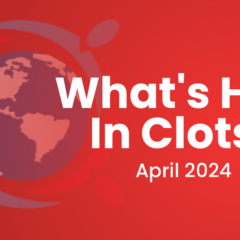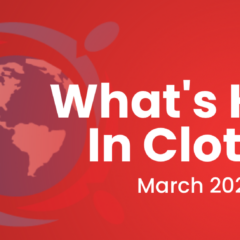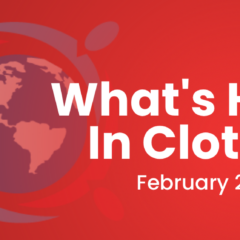Last updated on
Trial Tidbits: A Clinician’s Guide to ACC 2020
The 2020 American College of Cardiology, together with the World Congress of Cardiology, hosted the first-ever virtual Scientific Sessions from March 28-30. Here’s a handy guide to some of the big trials you might have missed.
VOYAGER PAD
Participants
- 6,564 patients with symptomatic peripheral artery disease (PAD) who had lower limb revascularization
Trial Design
- International, double-blind trial
- Half of patients received rivaroxaban 2.5 mg twice daily + 100 mg of aspirin daily.
- The other half received placebo + 100 mg of aspirin daily.
- Patients were followed for a median of 28 months.
- Note: Half of participants took clopidogrel at the discretion of the physician treating them. (The use of clopidogrel was not part of the study design.)
Study Endpoints
- Primary endpoint: Composite of acute limb ischemia, major amputation for vascular causes, ischemic stroke, myocardial infarction (MI), or death from cardiovascular causes
- Primary safety endpoint: Rate of major bleeds according to the Thrombolysis in Myocardial Infarction (TIMI) bleeding classification*
*Fatal bleeding, overt bleeding with drop in hemoglobin ≥5 g/dl or a 15% drop in hematocrit, and any intracranial hemorrhage
Key Findings
- There were lower event rates in patients taking rivaroxaban + aspirin vs. aspirin alone (17.3% vs. 19.9%, respectively), resulting in a 15% absolute risk reduction.
- The rivaroxaban + aspirin group had more bleeding (2.7%) than the aspirin group (1.9%), but the difference was not statistically significant.
- There was no excess in severe or fatal bleeding (e.g., intracranial hemorrhage).
Study Limitations
- More patients prematurely discontinued treatment than anticipated.
The Bottom Line
- Dual therapy with rivaroxaban + aspirin safely and effectively reduced the rate of ischemic events and was superior to aspirin alone in patients with symptomatic PAD.
- Patients with PAD who have undergone revascularization are at high risk for acute limb ischemia; this trial provides an evidence-based treatment strategy for these patients.
- VOYAGER PAD further supports findings from the COMPASS trial, which showed that low-dose rivaroxaban + aspirin significantly decreased major adverse heart events in patients with coronary artery disease (CAD) and PAD.
Corresponding Publication
Bonaca MP, Bauersachs RM, Anand SS, et al. N Engl J Med. 2020. [Epub ahead of print].
CARAVAGGIO
Participants
- 1,170 patients with cancer-associated thrombosis (CAT)
Trial Design
- Multinational, noninferiority trial
- Half of patients received 10 mg of apixaban twice daily for seven days followed by 5 mg twice daily.
- The other half received 200 units/kg of subcutaneous (SQ) dalteparin once a day for one month, followed by 150 units/kg once daily.
- Patients were followed for 6 months (the total course of treatment in both study arms).
Study Endpoints
- Primary endpoint: Recurrent venous thromboembolism (VTE)
- Primary safety endpoint: Major bleeding
Key Findings
- In the apixaban group, 5.6% of patients had recurrent VTE vs. 7.9% of patients in the dalteparin group.
- Major bleeding occurred in 3.8% of patients in the apixaban arm vs. 4.0% of patients in the dalteparin arm.
- Apixaban was not associated with increased gastrointestinal (GI) bleeding compared with dalteparin.
Study Limitations
- The sample size was only powered for the primary outcome and not powered to drive conclusions about bleeding.
- Findings cannot be generalized to all types of cancer. (Patients with basal-cell or squamous-cell skin cancer, brain tumors, known intracerebral metastases, or acute leukemia were excluded from the study.)
The Bottom Line
- Apixaban is at least as effective as dalteparin—the current standard of care—in treating CAT.
- Apixaban was not associated with excess major bleeding or increased GI bleeding, both of which are concerns in patients on anticoagulation.
- The data may broaden the use of apixaban in patients with CAT and provide them with a less cumbersome treatment option than dalteparin.
Corresponding Publication
Agnelli G, Becattini C, Meyer, G, et al. N Engl J Med. 2020. [Epub ahead of print.]
PRONOMOS
Participants
- 3,604 patients undergoing nonmajor orthopedic limb surgery*
*Achilles tendon repair, knee surgery, tibial or ankle fractures, or other similar procedures requiring >14 days of thromboprophylaxis; hip/knee replacements or hip fracture repair were excluded
Trial Design
- International, double-blind trial
- Half of patients received 10 mg of rivaroxaban daily + placebo injection.
- The other half received 40 mL of SQ enoxaparin daily + placebo tablet.
- The median duration of treatment was 28 days. (Treatment duration ranged from 2-8 weeks based on the discretion of the treating clinician and the anticipated timeframe of postsurgical immobilization.)
Study Endpoints
- Primary endpoint: Major VTE*
- Prespecified secondary outcomes: Major and clinically relevant nonmajor bleeding, overt thrombocytopenia, and death from any cause
*Composite of symptomatic distal or proximal DVT, pulmonary embolism (PE), or VTE-related death during the treatment period or asymptomatic proximal DVT at the end of treatment
Key Findings
- A major VTE event occurred in 0.24% of patients taking rivaroxaban vs. 1.1% of patients receiving enoxaparin.
- Bleeding rates did not differ between the study arms:
- Major + nonmajor clinically relevant bleeding: 1.08% in rivaroxaban arm vs. 1.04% in enoxaparin arm
- Major bleeding: 0.57% in rivaroxaban arm vs. 0.69% in enoxaparin arm
Study Limitations
- Study enrollment was halted early, leading to a smaller sample size than investigators planned.
- The study population was young and healthy (median age = 41), limiting generalizability to older populations.
- A discussant at the ACC session noted that enoxaparin is not frequently used for VTE prophylaxis outside the US.
The Bottom Line
- Compared with enoxaparin, rivaroxaban reduced the risk of major VTE by 75% in young patients requiring immobilization after lower limb orthopedic surgery.
- Rivaroxaban was not associated with an increased incidence of major bleeding or other bleeding events.
- The study showed that a once-daily oral anticoagulant can safely be used for postsurgical VTE prophylaxis instead of an injection.
Corresponding Publication
Samama CM, Laporte S, Rosencher N, et al. N Engl J Med. 2020. [Epub ahead of print.]
TICO
Participants
- 3,056 patients in South Korea with acute coronary syndrome (ACS) undergoing percutaneous coronary intervention (PCI)
Trial Design
- Open-label trial
- All patients received dual antiplatelet therapy (DAPT) with ticagrelor + aspirin for 3 months (the current standard of care).
- After 3 months, half of patients received DAPT and the other half received ticagrelor monotherapy.
- Patients were followed for 12 months.
Study Endpoints
- Primary endpoint: Net adverse clinical events* at 12 months
- Secondary outcomes:
- Major bleeding at 12 months
- Stent thrombosis at 12 months
*Death, MI, stent thrombosis, stroke, target vessel revascularization, or TIMI major bleeding
Key Findings
- Approximately 4% of patients in the monotherapy group had a primary-endpoint event vs. nearly 6% of patients receiving DAPT.
- There was a reduced risk of major bleeding in the monotherapy group vs. the DAPT group (1.7% vs. 3%, respectively).
Study Limitations
- The trial had an open-label design without placebo.
- Patients with an elevated bleeding risk* were excluded.
*Age ≥80, a history of stroke in past year, or traumatic brain injury or brain surgery in past 6 months
The Bottom Line
- After 3 months of DAPT, ticagrelor monotherapy was superior to DAPT in preventing bleeding and ischemic events in patients who underwent PCI for ACS.
- This study builds on findings from last year’s TWILIGHT trial and positions ticagrelor monotherapy as an emerging treatment option in post-PCI patients who receive DAPT for 90 days.
Additional studies you may be interested in:
- REDUCE-IT EPA trial: In this major prevention trial, patients who took 4 grams of prescription fish oil daily had increased blood levels of EPA, which correlated with a significant reduction in CV events and CV death.
- Insights from the COMPASS trial (diabetes subset): Patients with stable coronary disease, PAD, and diabetes who took 2.5 mg of rivaroxaban daily + aspirin had a larger absolute benefit on CV endpoints—including a 3-fold greater reduction in all-cause mortality—compared with the general population.



